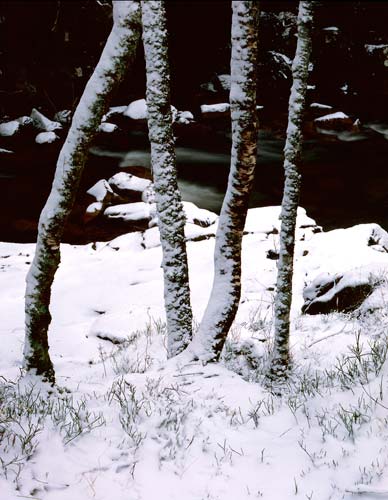How to Photograph Winter Landscapes
 Our fourth Christmas guest writer, one of Britain’s most accomplished large format photographers, David Ward from Light & Land, shares his top tips for taking great photos of winter landscapes.
Our fourth Christmas guest writer, one of Britain’s most accomplished large format photographers, David Ward from Light & Land, shares his top tips for taking great photos of winter landscapes.
Many people dream of the long, languorous days of summer, with its gentle, warm zephyrs. But, as a landscape photographer I dream of the short days of winter, preferably with snow and ice. Despite what you may think this isn’t simply a case of me being contrary. No, honestly, it isn’t! For me there are many compelling reasons why landscape photography is a more worthwhile experience in winter.
So, what’s wrong with summer? I usually find photographing the British landscape in the high summer months, between June and September, an unrewarding exercise. To my mind, wherever you are, summer limits photographic opportunities. In the mountains, warm southerly winds mean that vistas are irritatingly veiled by haze. Once the first, fresh green flush of spring has passed the pastoral landscape becomes drowned by an oppressive, dull green tide of foliage or, worse, flooded with the alien, acidic yellow of oilseed rape. Humans may be able to detect a greater variety of greens than any other colours in the spectrum but, for me, this ability doesn’t make verdant landscapes artistically appealing. England is often said to be green and pleasant but I would be horrified if this rather insipid expression were used to describe any of my images. The one ray of hope is that a journey to the coast may yield an image or two. But even this is beset with petty irritations; hoards of holidaymakers invade the coastline, their rampaging dogs taking every opportunity to leave footprints (or worse!) within your carefully framed image of pristine sand.

No, I’d much rather work in the short days of winter. Of course, as a lazy man, the thought of lying abed until ridiculously late hour of 7:00 am and still being up to catch the dawn is particularly appealing. But there are other, less frivolous, reasons why I think winter is best. Between October and early March in the UK the sun remains low enough in the sky for direct light to be interesting throughout the day. In fact north of the border in Scotland the light is good for an extra month either end of this period. I know what you’re going to say, “That’s if you see the sun!“ But the sun has hardly been a more common sight in any of our recent so called summers. The low angle of sunlight means good modelling of the elements in the landscape. It helps to give depth to a landscape image, strongly delineating foreground objects, highlighting texture and revealing the contours of the land. Such modelling is essential when photographing the vista and is one of the prime reasons why we love to make images around dawn and dusk at any time of the year.

I also find the winter palette of colours more interesting, particularly in upland Britain where the greens of summer are transformed to deep orange tones. Elsewhere, tall grasses taken on a golden hue and bracken turns through orange to light brown to burnt umber. In summer we work long hours to ensure that we can capture warm light, but in winter the landscape is often carpeted in warm tones. A touch of direct sunlight at any time of day will add vibrancy but these tones also work well in overcast conditions. Of course foliage doesn’t just change colour, in many cases it disappears completely. Denuded of leaves, skeletal trees provide wonderful opportunities for studies in form. Images of lone deciduous trees in winter can also evoke a stronger and wider range of emotional responses than in summer. Rather than just life the winter tree speaks of perseverance, strength, solitude, fortitude and perhaps melancholy. We should always search for photographic opportunities that evoke emotion rather than merely describe. Great photographs speak to our hearts as much as to our eyes.
Winter weather changes the landscape in many different ways but the most wonderful transformations occur in cold weather. In winter clear blue skies, which in summer bring only haze, are the harbingers of fog and frost. Fog adds mystery to the landscape. Concealing and revealing in equal measure it gives the photographer a greater control over emphasis, perhaps foregrounding a tree and hiding unwanted clutter. Frost is one of the most magical effects of winter. It seems to cleanse the landscape, wiping away the dull and dreary surfaces of wet days. Instead it highlights every edge with sparkling rime and covers water with crystalline patterns and swirls. Sadly hoar frosts, where trees become fabulous objects of glittering perfection, are largely a thing of the past.

There’s no doubt that making photographs in winter is more physically challenging but the cold is in some ways less of a problem for landscape photography than extreme heat. As some wag once said, “There’s no such thing as bad weather, only inadequate clothing!” In order to make good images in poor weather conditions it’s important to feel comfortable. In the British climate this means being ready for almost anything from rain to snow, from freezing fog to biting winds. If you’re venturing out into the hills it is essential that you check the weather forecast before you go and make sure that you’re adequately clothed. The key to good protection is layering; from a thermal base layer to a mid layer fleece and finally a waterproof and windproof outer layer. A hat and gloves are also essential. I favour split-palm gloves; these don’t inhibit dexterity and still provide reasonable protection against the cold. If it’s really chilly I might wear a thin pair of silk gloves under these. It’s not just you that can get cold; cameras don’t like extreme cold either. Battery life can be severely shortened so it’s a good idea to take plenty of spares and to keep them warm by storing them close to your skin.

A sense of childlike wonder is vital for a photographer because it allows them to see with a fresh eye and hence to open the eyes of their audience. For me nothing gives me this sense of wonder more than snow. My favourite definition of an adult is someone who finds snow merely an inconvenience. What a sad state of affairs that would be, I cannot help but find snow enchanting and uplifting. Snow can also simplify the landscape wonderfully and simplification is, for me, an essential element of a good landscape photograph. One of the basic processes of photography is distillation. Whereas painters start from the literal and metaphorical blank canvas, photographers are presented with the overwhelming complexity of the natural world and have to find some method of presenting it in the clearest, strongest way we can. Clarity is achieved not only by the arrangement of our subject within the image frame but, just as importantly, by careful decisions about excluding things from the image. Painters have to decide when to stop adding pigment but one of the key decisions for a photographer is when to stop excluding things, when to stop distilling reality. In fact the point at which we stop excluding in a key way defines the position of the frame. Beyond such conscious decisions we make about simplification we can also take advantage of nature’s ability to simplify. Snow is perhaps nature’s best method of simplification. It can bleed the colour from the landscape, transforming it into a fascinating abstraction, and it delineates elements by providing a blank ground for them to stand on. One only has to look at the stunning winter images of Japan by Michael Kenna to realise how powerful this simplification can be.

My advice would be to put your camera away in summer and save it for sipping a piña colada by the pool. Winter has so much to offer the landscape photographer; better light, shorter days, a wider palette of colours, magical weather transformations. So get out now to make the most of these opportunities – but don’t forget to put on an extra woolly!
Biography
http://www.lightandland.co.uk
http://www.into-the-light.com
David Ward is one of Britain’s most accomplished large format photographers. He has a very varied knowledge of photography, acquired while working for previous advertising, design and publishing clients. Over the years David has photographed everything from dogs to food to racing cars but landscape photography has always remained his passion.
In recent years he has concentrated his efforts on leading photography workshops for photo tour company Light & Land, taking groups to places as diverse as Utah and Norway. His emphasis in teaching is on the photographer’s vision, rather than on what equipment is being used, and he passes on his knowledge in a uniquely humorous and accessible manner. Light & Land runs a broad range of photographic workshops for all levels of photographers – both in the UK and worldwide – full details can be found at http://www.lightandland.co.uk
David has recently hosted Landscape Beyond - a hugely successful exhibition of his work at Londons OXO Tower gallery which was also the launch pad for Davids most recent book of the same title.
All images in this article © David Ward

Loading comments…